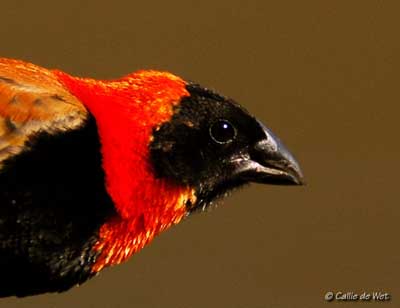
Fr: Euplecte ignicolore
All : Oryxweber
Esp: Obispo Rojo
Ital: Vescovo rosso
Nd: Grenadierwever
Callie de Wet
GALLERY
Text by Nicole Bouglouan
Sources:
HANDBOOK OF THE BIRDS OF THE WORLD Vol 15 by Josep del Hoyo-Andrew Elliot-David Christie - Lynx Edicions –
ISBN: 9788496553682
BIRDS OF AFRICA SOUTH OF THE SAHARA by Ian Sinclair and Peter Ryan - Princeton University Press Princeton and Oxford - ISBN: 0691118159
ROBERTS BIRDS OF SOUTH AFRICA by G. R. Mc Lachlan and R. Liversidge – The Trustees of the John Voelcker Bird Book Fuund – ISBN: 0620031182
L’ENCYCLOPEDIE MONDIALE DES OISEAUX - Dr Christopher M. Perrins - BORDAS - ISBN: 2040185607
Wikipedia (Wikipedia, The Free Encyclopedia)
Southern Red Bishop
Euplectes orix
Passeriforme Order – Ploceidae Family
BIOMETRICS:
Length: 13 cm
Weight: M: 21-30 g – F: 17-26 g
DESCRIPTION:
This beautiful inhabitant of the South African marshy grassland and cultivated areas in open country is a common species. Often seen perched on reeds, the bright plumage of the Southern Red Bishop is a jewel in this landscape.

Adult male in breeding season has black and red-orange plumage.
The upperparts are bright red-orange with red-brown back and mantle, slightly streaked blackish-brown. The nape, rump and uppertail-coverts are orange-red.
The upperwing and the tail are dark grey-brown with pale buff edges.
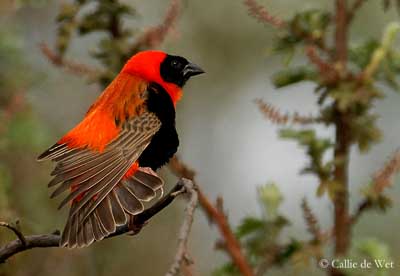
On the underparts, the lower breast, belly and flanks are black. The undertail-coverts are red-orange. The thighs are pale brown.
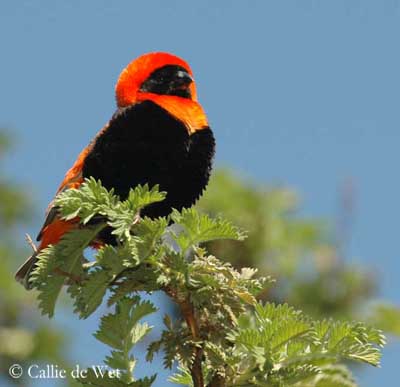
On the head, a black face mask includes the forehead, forecrown, lores, cheeks, chin and upper throat, with some variations of black extension according to each bird.
The rest of the head, the lower throat and the upper breast are red-orange.
The strong conical bill is black. Eyes are dark brown. Legs and feet are pale pinkish-brown.
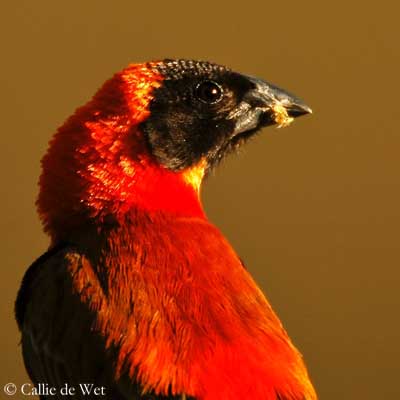
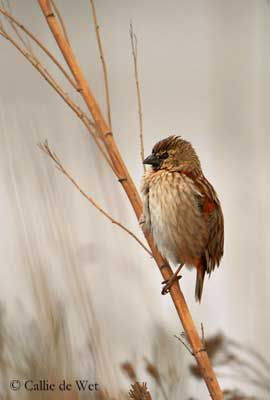
The non-breeding male has entire upperparts, from forehead to uppertail-coverts, brown with blackish-brown central streaks on feathers. We can see a yellowish supercilium. Lores, cheeks and ear-coverts are pale brown. Chin and throat are whitish. Breast and flanks are pale buff with fine central streaks. Belly, vent and undertail-coverts are white. Wings and tail are brown.
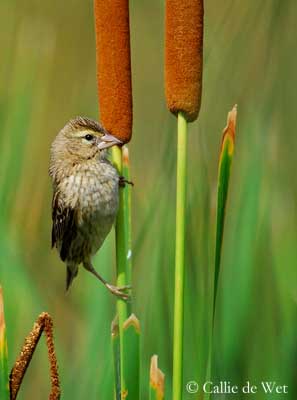
The female is very similar to the non-breeding male but she is smaller and less densely streaked on the underparts.
The bill, legs and feet are pale pinkish. Eyes are dark brown.
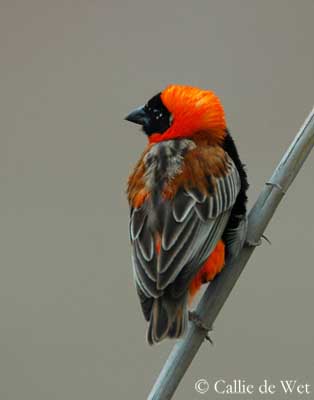
The juvenile resembles female with upperparts marked by broad buffy feathers edges, and buffy wash on the underparts.
The young male gets the red-orange and black plumage in the second breeding season.
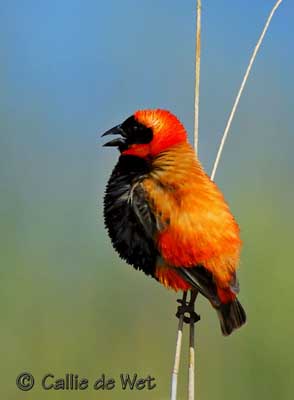
VOICE: SOUNDS BY XENO-CANTO
The Southern Red Bishop utters buzzy, chirping sounds as advertising calls. The contact call is a nasal “chip” or “wheet”. Alarm call is a harsh “chak”.
During the displays, the male sings from a perch and utters a hissing or prolonged sizzle “tsssssssss zeeeeeeeee tssipitsipip tsip-tsip-tsip”. This song is also given during the flight displays.
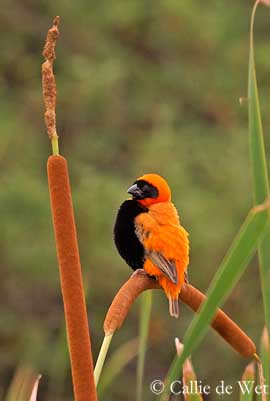
HABITAT:
The Southern Red Bishop frequents the open countries with grassland and agricultural areas, often near water. But it prefers to breed in reedbeds, in marshy areas.
This species can be found from sea-level up to 1500-1700 metres of elevation according to the range.
RANGE:
The Southern Red Bishop occurs in Africa, South of the Equator, from Cape Town in South Africa, to Somalia and Senegal northwards.
BEHAVIOUR:
The Southern Red Bishop feeds mainly on seeds and arthropods. The seeds come from numerous plant species and cereals. It also takes nectar from flowers. Insects are mainly taken during the nesting period, and include Coleoptera, Odonata, Lepidoptera, Diptera and Isoptera.
It catches the flying termites on the wing, but eats them on the ground or at perch. It may forage with Common Starlings in South Africa, often in seaweed on the shoreline in Western Cape. It also feeds on kelp flies and their larvae, and small crustaceans.
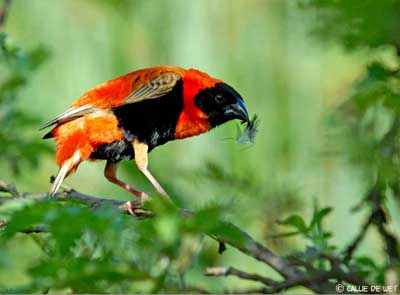
It usually feeds twice a day, in the morning and in the late afternoon. Between these two sessions, the birds gather at daytime roosts.
The Southern Red Bishop forages in small groups. Outside the breeding season, it can be seen in mixed flocks with Quelea species.
The Southern Red Bishop male is polygamous and up to seven females or more may nest within the male’s territory. It performs several displays, from threat to courtship.
The threat display shows the male with fluffed out plumage, mainly the rump, exposing its black facial mask surrounded by the red-orange ruff.
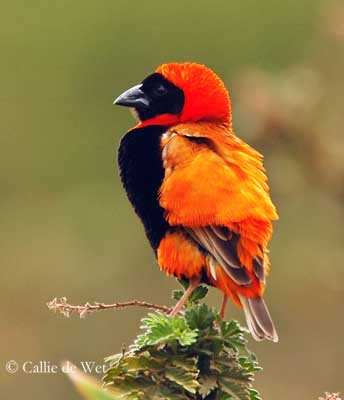
Courtship displays involve fluffed out plumage too.
Other displays such as chases far from the nest are followed by “nest-invitation” displays during which the male tries to attract the female. Then, the male performs aerial displays over the territory to attract her.
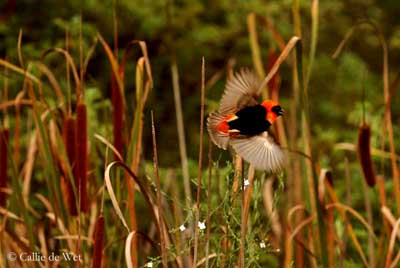
It performs some approach by “bumble-flight” to the female within the territory. Its plumage is always fluffed out and the rapid wing-beats produce a buzzy sound. Then, it perches, swivels around and sings.
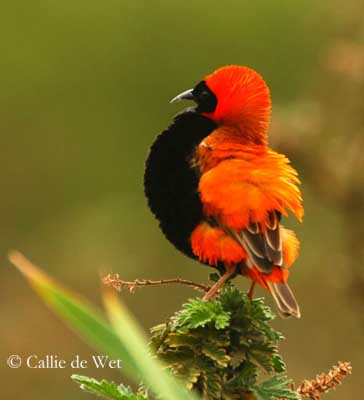
The Southern Red Bishop is mainly resident within its range. The male may return to the same colony and the same territory for up to five successive years.
FLIGHT:
The Southern Red Bishop performs Bumble-Bee-like flight with rapid wing-beats producing buzzy sounds during the breeding period. It flies airily about over the reedbed, with fluffed out plumage.
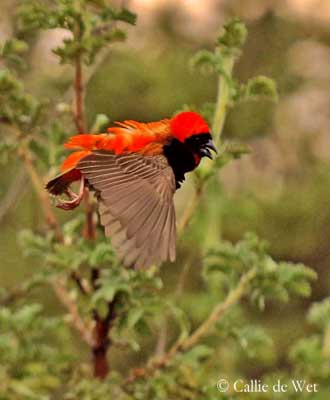
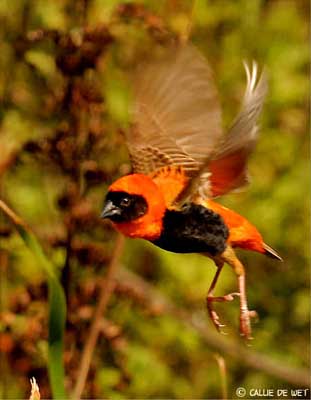
REPRODUCTION:
The breeding season varies according to the range.
This species nests in colonies where up to thousands birds may nest in the same single reedbed.
The Southern Red Bishop male is polygamous, and several females, up to seven or more, nest within its territory.
The male builds several nests, an oval shell with an entrance at top on one side. The construction starts with a cross-bridge between two vertical supports. Then, thin strips of reed or grass blades are woven together to form an oval structure. This work can last two or three days.
The female lines the interior with plant down and grass seed heads, and continues during the incubation.
This nest is usually placed in reeds, sedges and other aquatic plants standing in water, and often 2 metres above the water. The Southern Red Bishop can also breed in maize or crops in the fields.
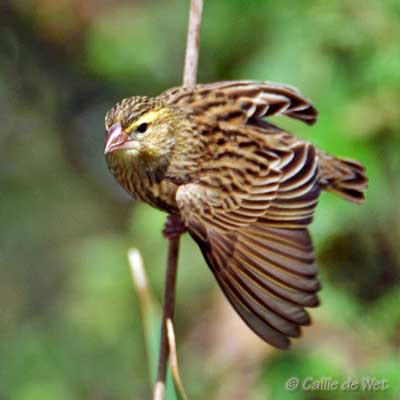
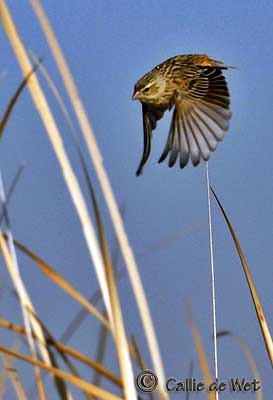
The female lays 3 pale blue-green or turquoise eggs. Sometimes, two females lay in the same nest, involving double brood. The incubation lasts about 12-13 days by female. She also feeds the chicks, first by regurgitation of seeds. They fledge 11-15 days after hatching, but they are able to leave the nest at 10 days of age if they are disturbed.
The young male can breed at two years whereas the young female can breed at one year.
The Southern Red Bishop’s nest is regularly parasitized by the Dideric Cuckoo. The male Bishop attacks the cuckoos at the colony very strongly.
DIET:
The Southern Red Bishop feeds mainly on seeds and arthropods.
The seeds are those of maize and wheat, but about 24 plant species are mentioned. It also feeds on several insect’s species such as beetles, dragonflies, caterpillars, flies and termites. It also takes spiders and small crustaceans, kelp flies and their larvae in seaweeds on beaches.
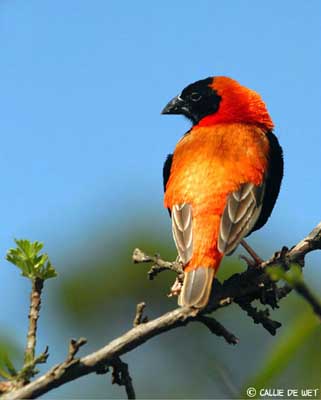
PROTECTION / THREATS / STATUS:
The Southern Red Bishop is common to locally abundant, and has expanded its range, taking advantage from cultivated areas.
It may damage the crops and is considered as pest in wheat-growing areas in South Africa. The species is unprotected in some regions.
The predation by snakes, rodents and other small mammals is the most important cause of nest failures. Adult are preyed upon by Cattle Egrets and other large birds.
However, the species is not globally threatened at this moment.
